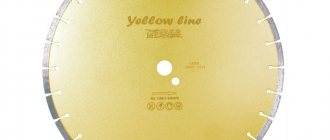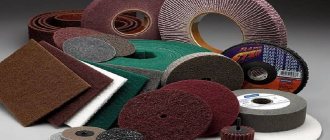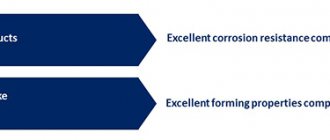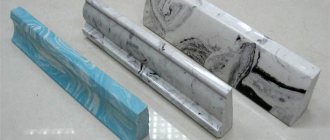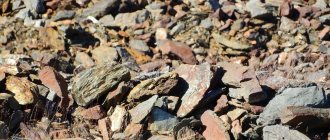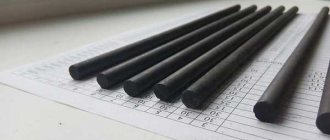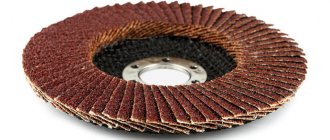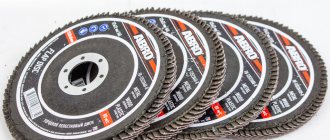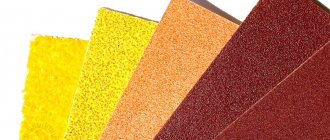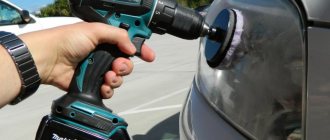Types of grinding wheels
There are 4 types of grinding discs:
- The sanding wheel is suitable for removing old paintwork. The surface of the disc looks like bristles made of metal wire. The circle is wear-resistant and rigid.
- A cord brush (twisted roller) is intended for rough grinding of materials and surfaces. The disc is perfect for removing varnish and paint from metal and wood, as well as when processing concrete.
- The end disc is designed for trimming previously sawn parts.
- The Velcro circle allows you to process stone and concrete surfaces. The discs are attached to the base using an adhesive base.
Flap discs are perfect for wood; the material has high wear resistance. The sandpaper petals are overlapping on the circle.
Classification of circles
Flap wheels have proven themselves well for cleaning metal from corrosion or paint, cleaning welds and removing burrs when processing metal by cutting or stamping. They are also used to prepare wood for coating with paint or varnish. The principle of operation of various circles is common - removing the top layer of material using an abrasive substance applied to the base.
Manufacturers supply the market with various types of grinding discs, especially for flat polishing and face grinding; there are also samples for cleaning internal, hidden volumes. The petal disc has increased elasticity.
Grinding wheel selection criteria
When choosing a wheel for a grinder, it is recommended to carefully familiarize yourself with its characteristics:
- Disc material. Marking from 12A to 16A electrocorundum is normal (characterized by heat resistance, excellent grain strength). Suitable for working with wrought iron, steel, cast iron and bronze. Marking from 22A to 25A for discs with a greater degree of coating uniformity, high hardness and self-sharpening ability. The higher the marking, the higher the hardness. Circles 52-22C and 62-64C are fragile.
- The size of the disk is standardized by GOST, where D is the outer diameter, d is the inner diameter, h is the height.
- Grain size: grain (fraction No. 200 to No. 16), powder (fraction No. 12 to No. 4), micro-grinding powder and fine micro-grinding powder (the finest grains).
- A type of disk.
- Abrasive hardness: VM1, VM2 – soft, WH – extremely hard.
- Grain binding material: R (B) vulcanite binder (rubber); V (K) – ceramic and V (B4 or BU) with artificial resins.
- The imbalance of the disk is the ratio of the mass of the circle to its shape. Class A indicates the permissibility of using the disk on high-precision equipment. Precision B is a universal disc, and circles marked AA have an ideal geometric shape.
- The structure of the disc is indicated by numbers: from 1 to 4 - dense (large amount of abrasive), 5-7 indicates an average coating density.
Marking
The main parameters of the circle can be determined by its symbol, which is indicated in the product labeling. The symbol corresponds to GOST R 52781 and indicates:
- circle type;
- material;
- grain;
- geometric parameters (outer and inner diameters, height);
- type of ligament;
- structure and degree of hardness;
- the highest permissible processing speed.
The exception is wheels with individual markings, which have wheels from foreign manufacturers. When purchasing this product, you must study the information in the catalogs and on the packaging.
The best velcro sanding discs
Makita P-43533 with Velcro from the famous Japanese company allows you to quickly change disks during operation.
- Users note the high-quality Velcro that securely fastens the disk.
- The high density of the abrasive coating allows the wheel to be used for a long time, and the holes in the disk quickly remove dust from the coating being sanded.
The German power tool brand offers the Hammer 214-012 with a durable fabric base.
- The disc has high flexibility and wear resistance characteristics.
- The water-repellent coating keeps the circle from getting wet.
- The coating grit is P400, the artificial resin reliably binds the abrasive material.
- Aluminum grains are capable of self-sharpening during operation.
Wolverine 435150, made in China, is characterized by high performance. Grit P150. Its versatility and low cost make Wolverine one of the best brands of velcro sanding wheels.
Circle grain
Petal circles are distinguished by grain size. There are several standard grain sizes - 40, 60, 80, 120. In accordance with Russian standards, the higher the number, the larger the grain diameter. According to foreign nomenclature, on the contrary, a larger number corresponds to a finer grain.
Read also: Michael Faraday and James Maxwell discoveries
When choosing a wheel, you must remember that with a high grain size, the processing will become rougher and the processed surface will be rougher.
Best Sanding Discs (Bolt-On)
- Model 3M 57018 is distinguished by reliable fixation and increased strength. The sanding disc is suitable for long-term use under intense loads. The design of the abrasive is three-dimensional, so the disc does not deform even during high-speed rotations of the wheel. The model is characterized by increased wear resistance, elasticity and the ability to cool quickly.
- Stayer 36228-150-6.0 is made using multilayer reinforcement technology (fiberglass mesh). The disc is characterized by a long service life, strength and resistance to deformation. Aluminum grains can be used when the circle rotates over 10 thousand revolutions per minute. Stayer perfectly cleans welds and removes burrs from metal.
- ZUBR 36204-150-6.0 z02 is also produced using the reinforcement method (polyamide mesh). The grinding disc is highly durable and ready for intensive work for a long time. Abrasive – aluminum oxide. However, the grinding wheel is only suitable for rough processing of materials.
What are diamond wheels for metal used for?
Diamond grinding wheels are one of the types of diamond tools. These devices are used to equip machines and electrical equipment. Diamond wheels are rarely used for manual operations.
Photo No. 1: diamond grinding wheels for metal
The main areas of application of these devices are machine tool and mechanical engineering. More highly specialized areas of use include:
- medicine;
- instrument making;
- production of porcelain, glass and crystal products;
- dentistry (dental prosthetics).
The following basic operations are performed using diamond wheels for metal.
- Sharpening of parts and tools (incisors, scalpels, knives, etc.).
- Honing.
- Finishing.
- Grinding.
- Polishing.
- Rip-off.
- Rough finish.
Most often, diamond wheels are used for processing workpieces and products from:
- hard alloys and other difficult-to-process materials;
- glass;
- ceramics.
In addition, semi-precious, semi-precious and precious stones are processed with diamond wheels.
TOP 3 flap discs for grinding
In the Bosch X-Lock X571 grinding wheels, the petals are based on an abrasive made of zirconium and aluminum.
- The material is perfect for long-term and intensive work with metal.
- The X-Lock disc mounting system makes it easy to change the disc during operation.
- Among the “advantages” of the model, it is necessary to note the solid base and reinforced design of the petals.
- Bosch will help you sand metal easily, even when working with heavy loads.
The Russian Master PM90337 is more difficult to install, but it has proven itself well even when operating at speeds over 13 thousand rpm.
- The base of the circle is made of fiberglass, which ensures the material's resistance to wear.
- The design of the petals ensures comfortable operation.
- Zirconium oxide is used as an abrasive material, which does not overheat and is not afraid of abrasion.
- Professionals recommend using the Russian Master grinding wheel when working with aluminum, brass, and bronze.
Dronco 5211384 consists of cotton and polyester, which indicates the flexibility and durability of the material.
- The grinding disc is based on a glass mesh, which allows the wheel to be used under heavy loads.
- Dronco does not leave scratches, so the circle is used for decorative work. Recommended for the final stage of sanding.
By studying the characteristics of various grinding wheels, you can easily choose the ideal disc at an affordable cost.
Professionals recommend carefully studying the description of grinding wheels and selecting the right material for certain types of work.
Purpose of abrasives
Depending on the type of abrasive from which the grinding wheel is made, the scope of its application changes.
Normal electrocorundum has good viscosity, adhesion to the binder, and is heat-resistant and is well suited for working with steel, cast iron, bronze and brass due to its physical properties.
White electrocorundum has a more uniform structure, sharp edges, is harder than ordinary corundum and has less surface roughness. Designed for processing the same materials as conventional electrocorundum, but due to less heating and wear, it is also used for alloy and tool steels, sharpening saw teeth, cutting edges of milling cutters, knives, drills. Well suited for polishing products.
Silicon carbide is harder, but more brittle than electrocorundum. It has a higher abrasive ability, but the adhesion of the grain to the binder is weaker than that of corundum.
Used to work with hard but brittle substances - glass, porcelain, ceramics, granite, as well as for compounds with high viscosity - rubber, copper, aluminum, heat-resistant steels.
Diamond has great mechanical strength, but is sensitive to high temperatures, reacts with iron, is brittle, and has very good self-sharpening properties, which gives the blade durability.
Diamond grinding wheels are used for processing materials such as cast iron, glass, ceramics, and hard alloys. Well suited for finishing products, sharpening drills, cutters, saws, knives.
Elbor is second only to diamond in hardness, does not react with iron, is heat-resistant, fragile, and has good abrasive ability.
Used for grinding and processing of hard steels, tool sharpening, finishing, the scope of application of CBN includes areas where other abrasives are not used due to high operating temperatures.

